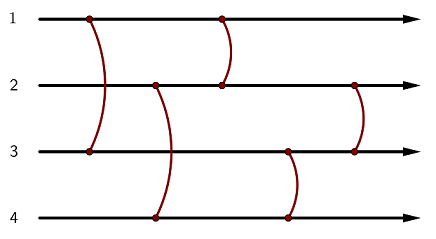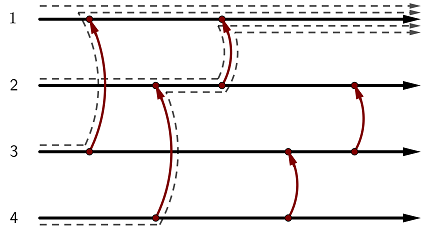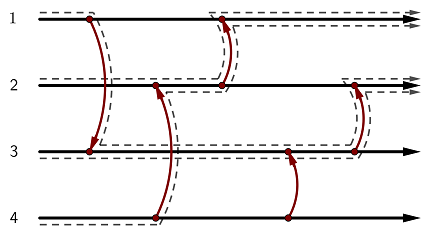Score : 1600 points
Problem Statement
A balancing network is an abstract device built up of N wires, thought of as running from left to right, and M balancers that connect pairs of wires. The wires are numbered from 1 to N from top to bottom, and the balancers are numbered from 1 to M from left to right. Balancer i connects wires x_i and y_i (x_i < y_i).

Each balancer must be in one of two states: up or down.
Consider a token that starts moving to the right along some wire at a point to the left of all balancers. During the process, the token passes through each balancer exactly once. Whenever the token encounters balancer i, the following happens:
- If the token is moving along wire x_i and balancer i is in the down state, the token moves down to wire y_i and continues moving to the right.
- If the token is moving along wire y_i and balancer i is in the up state, the token moves up to wire x_i and continues moving to the right.
- Otherwise, the token doesn't change the wire it's moving along.
Let a state of the balancing network be a string of length M, describing the states of all balancers.
The i-th character is ^ if balancer i is in the up state, and v if balancer i is in the down state.
A state of the balancing network is called uniforming if a wire w exists such that, regardless of the starting wire, the token will always end up at wire w and run to infinity along it. Any other state is called non-uniforming.
You are given an integer T (1 \le T \le 2). Answer the following question:
- If T = 1, find any uniforming state of the network or determine that it doesn't exist.
- If T = 2, find any non-uniforming state of the network or determine that it doesn't exist.
Note that if you answer just one kind of questions correctly, you can get partial score.
Constraints
- 2 \leq N \leq 50000
- 1 \leq M \leq 100000
- 1 \leq T \leq 2
- 1 \leq x_i < y_i \leq N
- All input values are integers.
Partial Score
- 800 points will be awarded for passing the testset satisfying T = 1.
- 800 points will be awarded for passing the testset satisfying T = 2.
Input
Input is given from Standard Input in the following format:
N M T x_1 y_1 x_2 y_2 : x_M y_M
Output
Print any uniforming state of the given network if T = 1, or any non-uniforming state if T = 2. If the required state doesn't exist, output -1.
Sample Input 1
4 5 1 1 3 2 4 1 2 3 4 2 3
Sample Output 1
^^^^^
This state is uniforming: regardless of the starting wire, the token ends up at wire 1.

Sample Input 2
4 5 2 1 3 2 4 1 2 3 4 2 3
Sample Output 2
v^^^^
This state is non-uniforming: depending on the starting wire, the token might end up at wire 1 or wire 2.

Sample Input 3
3 1 1 1 2
Sample Output 3
-1
A uniforming state doesn't exist.
Sample Input 4
2 1 2 1 2
Sample Output 4
-1
A non-uniforming state doesn't exist.